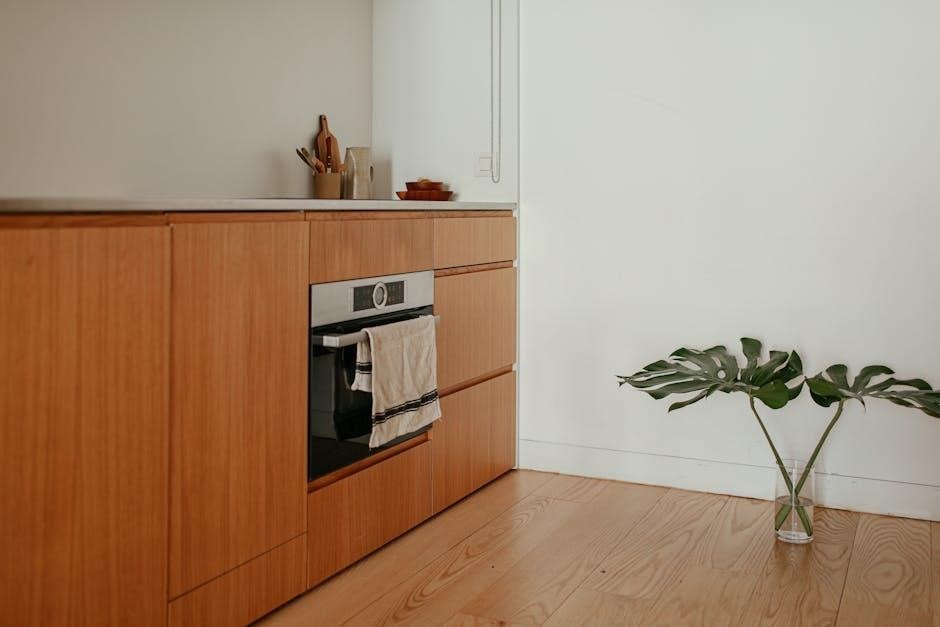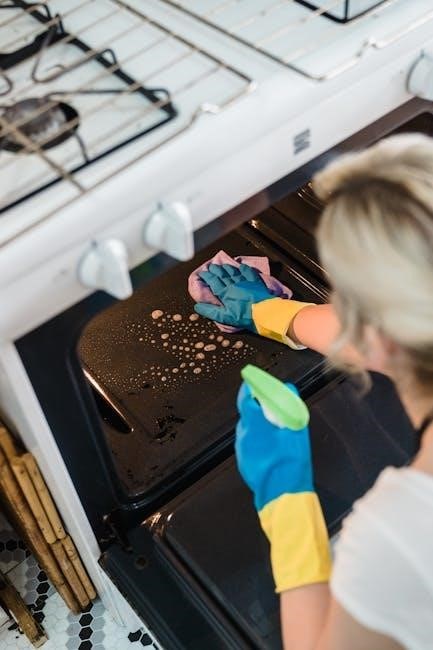Understanding GE Self-Cleaning Ovens
GE self-cleaning ovens offer a convenient and efficient way to maintain oven cleanliness. They use high temperatures to decompose food residue, leaving ash for easy removal. The steam clean feature provides quick cleaning for minor spills, while the high-temperature mode tackles heavy soil. These ovens are designed to minimize manual effort and reduce the need for harsh chemicals, making them a practical choice for homeowners.
GE self-cleaning ovens are designed to simplify oven maintenance by using high temperatures to decompose food residue into ash, eliminating the need for harsh chemicals. With features like high-temperature cleaning and steam clean options, these ovens provide efficient and convenient solutions for homeowners. The self-cleaning process is initiated through the control panel, ensuring a hands-off approach to oven care. This innovative technology not only saves time but also reduces manual effort, making it a practical choice for maintaining a clean and hygienic kitchen environment.
Key Features of GE Self-Cleaning Ovens
GE self-cleaning ovens boast advanced features that enhance cleaning efficiency. High-temperature self-cleaning reaches 880°F, turning food residue into ash for easy removal. The steam clean feature quickly tackles minor spills without extreme heat. Models may include electronic or non-electronic controls, with options for setting cleaning duration and intensity. Safety mechanisms like automatic door locking and indicator lights ensure secure operation. These features make GE ovens user-friendly, providing effective cleaning solutions while reducing manual effort and the need for harsh chemicals, ensuring a hygienic and well-maintained cooking environment.
How High-Temperature Self-Cleaning Works
GE self-cleaning ovens use high temperatures, reaching up to 880°F, to incinerate food residue, turning it into ash. This process eliminates the need for scrubbing, as the intense heat breaks down tough stains and grime. Before starting, racks and utensils are removed to prevent warping. Once the cycle begins, the oven door locks securely to ensure safety. After completion, the oven cools, and the ash is easily wiped away with a damp cloth, leaving the interior clean and ready for use.
Steam Clean Feature for Quick Cleaning
The Steam Clean feature on GE ovens provides a quick and gentle cleaning option for minor food spills. By using steam, it loosens debris without extreme heat, making cleanup effortless. This feature is ideal for light soil and maintains the oven’s interior without damaging surfaces. It’s a time-saving alternative to high-temperature cleaning, ensuring your oven stays clean with minimal effort and without harsh chemicals, perfect for everyday maintenance and keeping your oven in pristine condition.

Preparing for the Self-Cleaning Cycle
Before starting, remove racks, cookware, and utensils, and wipe loose food particles. Ensure the oven door is closed properly and handle heavy soil with a scouring ball if needed.
Removing Oven Racks, Cookware, and Utensils
Before initiating the self-cleaning cycle, remove all oven racks, cookware, bakeware, and utensils to prevent warping or damage from high heat. This ensures efficient cleaning and avoids obstruction. Also, take out any foil or silicone liners, as they can interfere with the process. Check for heavy soil or food residue and address it with a plastic scouring ball if necessary; Removing these items allows the oven to clean evenly and effectively, ensuring optimal performance and safety during the cycle.
Wiping Away Loose Food Particles
Before starting the self-cleaning cycle, wipe away loose food particles using a damp cloth or sponge. This step prevents excessive smoke and odors during high-temperature cleaning. Focus on large debris, as smaller particles will be incinerated. Avoid using abrasive materials or harsh chemicals, as they can damage the oven’s interior. Ensure the oven floor is clear of debris to allow the self-cleaning process to work effectively. This preparatory step ensures a smoother and more efficient cleaning cycle, reducing the need for manual scrubbing afterward.
Closing the Oven Door Properly
Closing the oven door properly is essential before initiating the self-cleaning cycle. Ensure the door is fully shut and latched to create a tight seal, which is crucial for the high-temperature cleaning process. For models with window shields, slide the shield to the closed position before shutting the door. A properly closed door prevents heat from escaping, reduces smoke emission, and ensures the oven locks securely during the cycle. This step is vital for both safety and effective cleaning. Always double-check the door’s position before starting the cycle.
Handling Heavy Soil and Food Residue
For heavy soil and food residue, GE self-cleaning ovens require additional attention. Before starting the cycle, remove large debris using a plastic scouring ball and water. Avoid leaving thick layers of food, as they can cause excessive smoke. For extreme buildup, consider shorter cycles or manual pre-cleaning. Ensure racks and utensils are removed to prevent warping. Proper preparation ensures efficient cleaning and prevents damage to the oven interior. Always refer to the user manual for model-specific guidance on handling heavy soil effectively.

Initiating the Self-Cleaning Cycle
Press the Self-Clean button on the control panel, set the cleaning duration, and turn the knobs to the Clean position. The Clean Light will indicate the cycle has started.

Locating the Self-Clean Button on the Control Panel
The Self-Clean button is typically located on the control panel of your GE oven. It may be labeled as “Self-Clean” or have a specific icon. Depending on the model, the button might be a dedicated key or part of a multi-functional interface. Pressing this button activates the self-cleaning mode, allowing you to select the desired cleaning duration or intensity. Always refer to your oven’s Use and Care Guide for precise instructions, as button placement and functionality can vary slightly between models. Once located, pressing the button will initiate the cleaning cycle, indicated by the Clean Light.
Setting the Cleaning Duration and Intensity
After initiating the self-clean cycle, you can set the cleaning duration and intensity based on the level of soil buildup in your oven. For light soils, a 2-hour cycle is typically sufficient, while heavy soils may require a 3-hour cycle. Some models allow you to choose the cleaning intensity directly, ensuring optimal results for different scenarios. Adjust the settings using the control panel, following the instructions in your GE oven’s Use and Care Guide. Properly setting these parameters ensures effective cleaning without unnecessary energy use.
Understanding the Latch Release Button
The latch release button is a critical safety feature on GE self-cleaning ovens. It secures the oven door during the cleaning cycle, ensuring it remains locked at high temperatures. To engage, push and hold the button while sliding the latch to the Clean position. This prevents accidental opening and potential burns. After the cycle completes and the oven cools, the button allows you to unlock the door safely. Always ensure the latch is properly engaged before starting the self-clean cycle to maintain safety and effectiveness during the process.
Turning the Oven Knobs to the Clean Position
Turning the oven knobs to the Clean position is essential to initiate the self-cleaning cycle. Locate the oven set and temperature knobs on your GE oven. Rotate them clockwise to the Clean position or select the desired temperature if no specific Clean setting exists. This action triggers the self-cleaning process, ensuring high heat is applied to decompose food residue. Ensure the oven is properly prepared and the latch is secure before proceeding. Always refer to your oven’s user manual for model-specific guidance on knob settings and cleaning durations.
Starting the Self-Clean Cycle
Starting the self-clean cycle on your GE oven is straightforward. Once the oven is prepared, press the Self-Clean button on the control panel. Select the desired cleaning duration or intensity based on soil level—typically 2 hours for light soil or 3 hours for heavy. Confirm your selection, and the Clean Light will illuminate, indicating the cycle has begun. Ensure the oven door is securely closed and latched. The Lock Light will activate shortly, ensuring safety. Allow the cycle to complete without interruption for optimal results.
Interpreting the Clean Light and Lock Light Indicators
The Clean Light and Lock Light indicators are essential for monitoring the self-cleaning process. The Clean Light illuminates when the cycle starts and remains on throughout, signaling active cleaning. It turns off once the cycle completes. The Lock Light activates after about 30-40 minutes, indicating the oven door is securely locked for safety. Once the cycle finishes and the oven cools, the Lock Light turns off, allowing you to unlatch and open the door. These lights ensure safe and efficient operation during the self-cleaning process;

During the Self-Cleaning Cycle
During the self-cleaning cycle, the oven emits smoke and odor, requiring proper ventilation. Ensure the kitchen is well-ventilated to prevent fumes buildup and maintain air quality. Keep children and pets away for safety, as surfaces become extremely hot. Avoid interrupting the cycle or opening the door, as this could damage the oven or cause burns. Monitoring the process is crucial, but from a safe distance, allowing the cycle to complete without interference.
Normal Smoke and Odor Emission
During the self-cleaning cycle, it is normal for smoke and odor to be emitted due to the high temperatures breaking down food residue. These fumes are a natural part of the cleaning process but may be more pronounced with heavy soil buildup. To manage this, ensure proper ventilation by opening windows or using a range hood. Avoid panic, as this is a standard occurrence. However, excessive smoke may indicate a need to clean more frequently or address large food debris before starting the cycle.
Ensuring Proper Ventilation
Ensuring proper ventilation is crucial during the self-cleaning cycle to prevent smoke and odors from spreading throughout your home. Open windows or turn on a range hood to improve airflow and reduce fumes. This helps dissipate the smoke generated by the high temperatures breaking down food residue. Proper ventilation not only minimizes unpleasant smells but also ensures the cleaning process remains safe and efficient. It is important to avoid using harsh chemicals, as the oven’s high heat handles cleaning naturally.
Avoiding Interruptions or Opening the Door
Never interrupt the self-cleaning cycle or open the oven door during operation. The oven reaches extreme temperatures, and opening the door can cause serious burns or damage. The door lock ensures safety by securing it shut throughout the cycle. Avoid stopping the cycle prematurely unless absolutely necessary, as this can disrupt the cleaning process. Always wait for the cycle to complete and the oven to cool before opening the door. This ensures optimal cleaning results and prevents potential hazards.
Kitchen Safety: Keeping Children and Pets Away
Ensure kitchen safety by keeping children and pets away during the self-cleaning cycle. The oven reaches extremely high temperatures, making surfaces dangerous to touch. Supervise closely to prevent accidental burns or injuries. Use baby gates or barriers to restrict access to the kitchen. Never allow children to play near the oven during cleaning. Pets should also be kept at a safe distance to avoid curiosity-driven accidents. Prioritize their safety and well-being by maintaining a secure environment throughout the cleaning process.

Post-Cleaning Steps
After the self-cleaning cycle, allow the oven to cool completely. Wipe away ash with a damp cloth, return racks and utensils, and perform a final inspection.
Allowing the Oven to Cool Down Completely
After the self-cleaning cycle, let the oven cool completely before opening. This ensures safety, as surfaces remain extremely hot. The cooling period allows food residue to fully transform into ash, making cleanup easier. Never attempt to open the door or touch internal components while the oven is hot. Wait until the Lock Light turns off, indicating it’s safe to proceed. Proper cooling prevents burns and damage, ensuring the oven is ready for its next use. Always prioritize patience to avoid accidents during this critical step.
Wiping Away Ash and Residue
Once the oven has cooled, use a damp cloth or sponge to wipe away the ash and residue. Avoid using abrasive materials to prevent scratching the interior. For tougher spots, a plastic scouring ball can be effective. After wiping, inspect the oven to ensure all residue is removed. Replace oven racks and utensils, and your oven is ready for use. This step completes the cleaning process, leaving your oven clean and maintained without harsh chemicals.
Returning Oven Racks and Utensils
After the self-cleaning cycle and once the oven is cool, carefully place the oven racks and utensils back inside. Ensure they are secure and properly positioned. Avoid damaging the racks or the oven interior. This step restores functionality and prepares the oven for future use. Always handle racks with care to prevent scratching the oven surfaces. Once everything is in place, your oven is ready for cooking again, ensuring optimal performance and safety.
Final Cleaning and Inspection
After the self-cleaning cycle, once the oven is cool, perform a final wipedown using a damp cloth to remove any remaining ash or residue. Inspect the oven interior, racks, and utensils to ensure all surfaces are clean and free of debris. Check for any stubborn spots that may require additional attention. This step ensures the oven is spotless and ready for its next use, maintaining its efficiency and safety standards. Proper inspection helps prevent future cleaning challenges and guarantees optimal performance.

Safety Precautions
Never open the oven door during the self-cleaning cycle to avoid burns. Keep children and pets away. Ensure the oven clock is working and the lamp cover is secure. Avoid using foil or silicone liners, as they can damage the oven. Always allow the oven to cool before cleaning or touching surfaces. Proper ventilation is essential to prevent smoke and odor buildup during the cycle.
Never Opening the Door During Cleaning
Never open the oven door during the self-cleaning cycle, as temperatures reach 880°F, causing severe burns. The oven locks automatically to prevent accidental opening. Opening the door releases harmful smoke and odors, potentially damaging the oven. Wait until the cycle completes and the oven cools before unlatching. This ensures safety and prevents interference with the cleaning process. Always prioritize caution and follow manufacturer guidelines to avoid accidents and maintain the oven’s functionality.
Avoiding Touching Hot Surfaces
Avoid touching the oven or its door during the self-cleaning cycle, as they become extremely hot. The oven reaches temperatures of 880°F, posing serious burn risks. The door locks automatically to prevent accidental opening, ensuring safety. After the cycle, allow the oven to cool completely before touching any surfaces. Use oven mitts or tongs when handling racks or utensils post-cleaning. Never attempt to open the door or touch internal components until the oven has cooled down, as residual heat can still cause burns.
Ensuring the Oven Clock is Working
Before starting the self-cleaning cycle, ensure the oven clock is functioning correctly. A malfunctioning clock can disrupt the cleaning process and safety features. If the clock is not working, do not initiate the self-clean cycle until it is repaired. Proper timekeeping ensures the cycle runs for the correct duration, preventing overheating or incomplete cleaning. Always verify the clock’s accuracy to maintain oven performance and safety during the self-cleaning process.
Checking the Oven Lamp Cover
Before starting the self-cleaning cycle, ensure the oven lamp cover is securely in place. A missing or damaged cover can expose the lamp to heat, potentially causing damage or creating safety hazards. If the cover is missing, replace it before initiating the cycle; A properly installed lamp cover protects the bulb during high-temperature cleaning and ensures optimal oven performance. Always verify the lamp cover’s condition to maintain safety and functionality during the self-cleaning process.
Avoiding Foil or Silicone Liners
When using the self-cleaning feature on your GE oven, it’s essential to avoid using foil or silicone liners. These materials can melt or catch fire during the high-temperature cleaning cycle, potentially damaging the oven or causing safety hazards. Always remove any liners before starting the self-cleaning process to ensure a safe and effective cleaning experience. For model-specific guidance, consult your oven’s Use and Care Guide.

Maintenance and Tips
Regular self-cleaning cycles help maintain oven efficiency. Avoid harsh chemicals and abrasive cleaners, as they can damage the interior. Ensure proper ventilation during cleaning to reduce smoke and odors. Monitor the cleaning process to prevent overheating or damage. Always refer to your GE oven’s Use and Care Guide for model-specific tips and safety precautions. Periodic cleaning ensures optimal performance and longevity of your oven.
Periodic Self-Clean Cycles for Maintenance
Performing periodic self-clean cycles is essential for maintaining your GE oven’s performance and longevity. These cycles remove food residue and prevent buildup, ensuring efficient cooking and reducing odors. For light soil, a 2-hour cycle is sufficient, while heavy soil requires a 3-hour cycle. Regular cleaning also prevents the need for harsh chemicals, protecting the oven’s interior. Always follow the manufacturer’s guidelines and ensure the oven is cool before wiping away ash. This practice keeps your oven in optimal condition and maintains its effectiveness over time.
Avoiding Harsh Chemicals
Avoiding harsh chemicals is crucial for maintaining your GE self-cleaning oven. The high-temperature cleaning feature eliminates the need for abrasive cleaners, which can damage the oven’s interior. Using chemicals can leave harmful residues and potentially damage the finish. Instead, rely on the oven’s self-cleaning cycle to break down food residue. After the cycle, a damp cloth is sufficient to wipe away ash. This approach ensures safety, prevents damage, and keeps your oven in optimal condition without exposing it to harmful substances.
Proper Ventilation Practices
Proper ventilation is essential during the self-cleaning cycle to manage smoke and odors. Open windows or use an exhaust fan to ensure air circulation. This helps prevent the buildup of harmful fumes in your kitchen. For optimal results, avoid relying solely on ventilation systems that recirculate air indoors. Instead, ensure fresh air flow by opening windows or using a range hood that vents outside. Proper ventilation enhances safety and comfort while maintaining your oven’s efficiency during the cleaning process.
Monitoring the Cleaning Process
Monitoring the cleaning process ensures safety and effectiveness. Check the oven’s progress by observing the Clean Light and Lock Light indicators. The Clean Light signals the cycle’s start and progression, while the Lock Light indicates the oven is securely locked. Avoid opening the door during the cycle, as high temperatures can cause burns. Keep an eye on the timer and ensure proper ventilation to manage smoke and odors. Stay nearby to address any unexpected issues, ensuring the process completes safely and efficiently without interruptions.

Troubleshooting Common Issues
Common issues include a malfunctioning oven clock, latch release problems, and smoke/odor concerns. Ensure the clock works, check the latch mechanism, and verify proper ventilation to resolve issues safely.
Malfunctioning Oven Clock
A malfunctioning oven clock can disrupt the self-cleaning cycle. Ensure the clock is set correctly and functioning before starting. If the clock fails, the self-clean feature may not initiate or complete properly. Resetting the clock or checking the power supply often resolves the issue. For persistent problems, refer to the user manual or contact a technician. A faulty clock can prevent proper timing and safety features during cleaning, so addressing this issue is crucial for effective and safe operation of the self-cleaning function.
Issues with the Latch Release Mechanism
Issues with the latch release mechanism can prevent the oven door from securing properly during the self-cleaning cycle. If the latch is stuck or malfunctioning, the door may not lock, posing a safety risk. Ensure the mechanism is clean and free from debris. If the problem persists, consult the user manual or contact a technician. A faulty latch can disrupt the cleaning process and compromise safety, so addressing this issue promptly is essential for proper oven function and user safety during self-cleaning cycles.
Smoke or Odor Concerns
Smoke and odor emission during the self-cleaning cycle are normal due to high temperatures breaking down food residue. Ensure proper ventilation by opening windows or using a range hood. Excessive smoke may indicate heavy soil buildup; clean large debris before starting the cycle. Avoid using foil or silicone liners, as they can intensify odors. After cleaning, wipe away ash thoroughly to eliminate lingering smells. Addressing these concerns ensures a safer and more efficient cleaning process for your GE self-cleaning oven.

Model-Specific Instructions
GE self-cleaning ovens vary by model, with unique features like latch mechanisms or control panel settings; Always consult your specific model’s Use and Care Guide for precise instructions.
Consulting the Use and Care Guide
Consulting the Use and Care Guide is essential for understanding your specific GE self-cleaning oven model. It provides detailed instructions for operating the self-clean feature, including duration, temperature settings, and safety precautions. The guide also covers troubleshooting common issues, such as malfunctioning clocks or latch mechanisms. Additionally, it offers tips for maintaining your oven and ensuring optimal performance. Always refer to this guide before starting the self-clean cycle to avoid potential damage or hazards. It’s your go-to resource for model-specific advice and safe operation.
Understanding Model Variations
GE self-cleaning ovens come in various models, each with unique features and settings. Some models offer electronic touch controls, while others use traditional knobs. Certain models include advanced features like smart home integration or steam cleaning options. The self-clean cycle duration and temperature settings may vary depending on the model. It’s important to familiarize yourself with your specific oven’s design, as instructions can differ slightly. For example, some models require setting a specific clean position on the knob, while others may have digital controls for cycle selection. Always refer to your model’s guide for precise instructions.
Adapting Instructions for Different Models
Adapting instructions for different GE self-cleaning oven models ensures optimal performance. For models with electronic controls, navigate through digital menus to select cleaning options. Manual knob models require turning dials to the clean position. Some ovens have a latch release button, while others automatically lock the door. Always consult the Use and Care Guide for model-specific details, as features like steam cleaning or variable intensity settings may vary. Adjusting settings according to your model’s specifications ensures a safe and effective cleaning process tailored to your oven’s capabilities.
GE self-cleaning ovens provide a convenient, efficient way to maintain cleanliness with minimal effort. Their high-temperature cleaning and steam features make them a practical, time-saving solution for homeowners.
Final Thoughts on GE Self-Cleaning Ovens
GE self-cleaning ovens are a practical solution for maintaining oven hygiene. Their high-temperature cleaning and steam features simplify the process, reducing the need for harsh chemicals. Regular use ensures long-term efficiency. Always follow the user manual for optimal results and safety. Proper maintenance and adherence to guidelines enhance performance. This feature-rich appliance is a valuable addition to any kitchen, offering convenience and effectiveness in keeping your oven clean and functional for years to come.
Additional Resources for Further Reading
For more detailed guidance, visit GE Appliances’ official website for specific model instructions and troubleshooting tips. Their Use and Care Guide provides in-depth information on self-cleaning cycles. Additionally, home improvement websites like House and Home Online offer step-by-step tutorials and safety advice. These resources ensure optimal use of your GE self-cleaning oven, helping you maintain its efficiency and longevity while adhering to safety standards. Consult these guides for a seamless self-cleaning experience tailored to your oven model.
